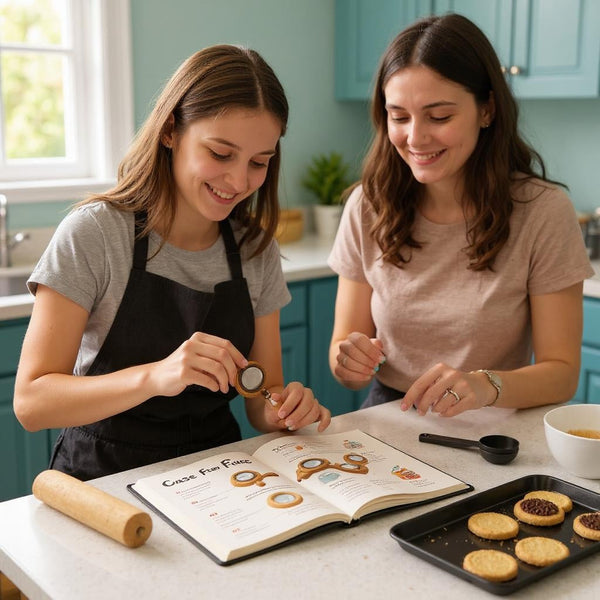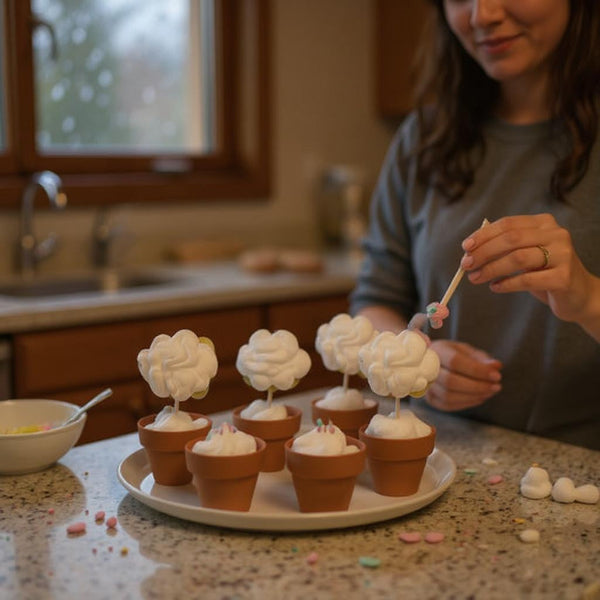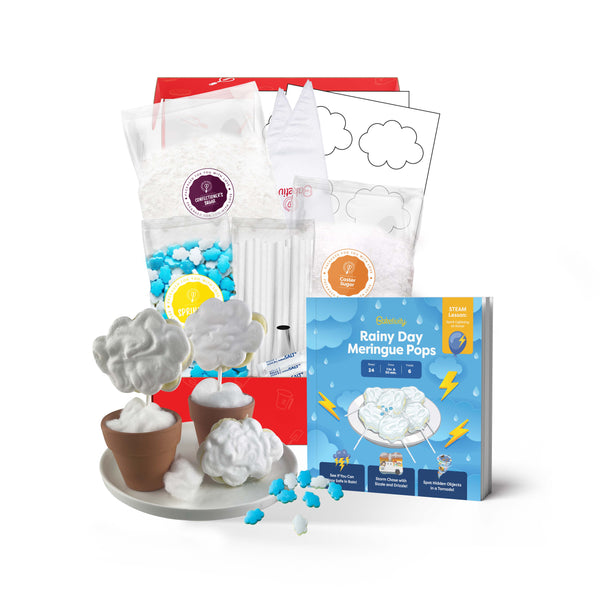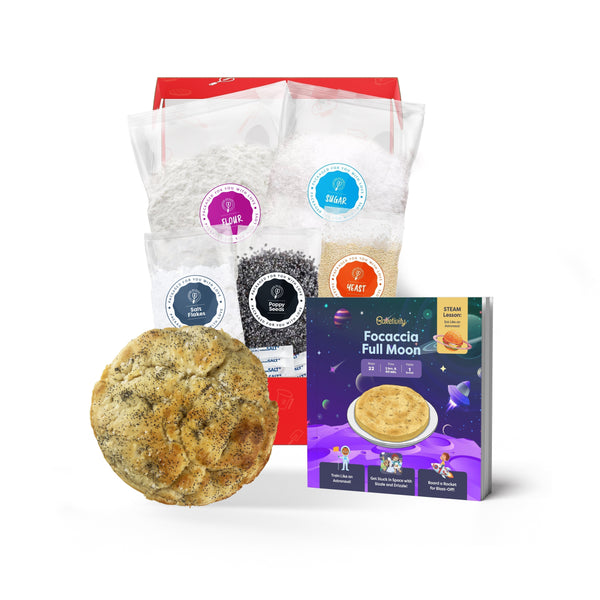Ever wondered how to turn your little ones into junior chefs? We've got the secret ingredient: kids' cooking books! These culinary guides are more than just recipes - they're gateways to a world of fun, learning, and delicious adventures in the kitchen.
From classic cookies to themed treats, kids' cooking books offer a smorgasbord of options for young bakers of all skill levels. They're not just about following instructions; they're about stirring up creativity, mixing in some kitchen science, and baking up confidence. Remember the first time you helped in the kitchen? That same magic awaits the next generation, and these books are the perfect recipe for success. So, are you ready to whip up some memories with your little chefs?
Key Takeaways
- Kids cooking books offer numerous benefits, including building kitchen confidence and developing essential life skills like math and reading
- Look for age-appropriate recipes, colorful illustrations, and safety tips when choosing cooking books for children
- These books cater to different age groups, from simple no-cook recipes for toddlers to complex meals for teens
- Cooking books incorporate educational elements like math, science, and cultural awareness through fun culinary activities
- Safety considerations, including age-appropriate guidelines and kitchen tool usage, are crucial aspects of kids cooking books
- Involving children in cooking through these books can help address picky eating habits and encourage trying new foods
Benefits of Kids Cooking Books
Kids cooking books offer numerous advantages for young chefs. They provide a fun and engaging way for children to learn about food, nutrition, and kitchen safety.
Building Confidence in the Kitchen
Cooking books designed for kids boost self-assurance in the kitchen. They break down complex recipes into simple steps, making them easy to follow. As children successfully create dishes, their confidence grows. This newfound self-belief often extends beyond the kitchen, positively impacting other areas of their lives.
Ever heard of a 7-year-old making spaghetti for the whole family? It's not a joke - it's what kids can do with the right guidance! Cooking books give kids the tools to tackle culinary challenges head-on, turning kitchen newbies into mini master chefs.
Developing Essential Life Skills
Kids cooking books teach more than just how to whip up tasty treats. They're packed with valuable life lessons. Following recipes helps children practice reading, math, and following instructions. They learn about measurement, fractions, and time management.
Cooking also fosters creativity. Kids can experiment with flavors, textures, and presentation. It's like painting, but with food as the canvas! And let's not forget about patience - waiting for cookies to bake can feel like an eternity for little ones.
Have you ever tried to explain fractions to a child? It's tough! But when you're dividing a pizza or measuring ingredients, suddenly math becomes delicious and makes sense.
Top Features to Look for in Kids Cooking Books

When choosing cooking books for kids, it's crucial to consider specific features that make them engaging and educational. We've identified key elements that transform ordinary recipe books into captivating culinary adventures for young chefs.
Age-Appropriate Recipes
Kids' cooking books should offer recipes tailored to different age groups and skill levels. Look for books that:
- Provide step-by-step instructions with simple language
- Include recipes with varying difficulty levels to grow with your child
- Offer cooking times suitable for kids' attention spans
- Feature dishes that appeal to children's taste preferences
- Incorporate basic kitchen skills that build gradually
Colorful Illustrations and Photos
Visual appeal is vital in keeping kids interested. The best cooking books for children:
- Use bright, eye-catching colors throughout
- Include clear, detailed photos of finished dishes
- Provide step-by-step illustrations for complex techniques
- Feature fun, cartoon-like characters to guide readers
- Use visual cues to highlight important safety tips
Remember when we tried to bake without pictures? It's like trying to build a LEGO set without instructions – chaos! Good illustrations can turn a kitchen disaster into a laughing matter. What's your funniest cooking mishap with kids?
Best Kids Cooking Books for Different Age Groups

Kids' cooking books cater to various age groups, offering age-appropriate recipes and culinary skills. Let's explore the best options for different stages of childhood development.
Preschoolers and Toddlers
Cooking books for preschoolers and toddlers focus on simple, fun recipes with bright illustrations. These books often feature:
- One-bowl recipes with minimal steps
- No-cook treats like fruit salads or sandwiches
- Large, colorful pictures of ingredients and utensils
- Interactive elements like flaps or textures
Some books incorporate counting or color recognition, turning cooking into a playful learning experience. Remember the time your little one mixed "mud pies" in the backyard? These books channel that creativity into edible masterpieces!
Elementary School Children
Elementary-aged kids are ready for more complex recipes and kitchen tasks. The best cooking books for this age group include:
- Step-by-step instructions with numbered lists
- Safety tips for using kitchen tools
- Basic nutrition information
- Fun facts about ingredients or cooking techniques
These books often feature themes like international cuisine or movie-inspired recipes. They're perfect for budding chefs who want to surprise the family with a homemade pizza night. Who knows? Your kitchen might soon smell like a mini Italian restaurant!
Tweens and Teens
Cooking books for tweens and teens offer more sophisticated recipes and techniques. They typically include:
- Diverse recipe options, from quick snacks to multi-course meals
- Information on meal planning and grocery shopping
- Tips for adapting recipes and experimenting with flavors
- Guidance on presentation and plating
These books encourage independence in the kitchen, preparing teens for cooking in college or their first apartment. Ever wondered how to make the perfect grilled cheese? Your teen might soon teach you a trick or two!
What's your favorite childhood cooking memory? Sharing these experiences can inspire the next generation of young chefs to create their own culinary adventures.
Educational Value of Kids Cooking Books
Kids cooking books offer a wealth of learning opportunities beyond the kitchen. They're powerful tools for developing various skills and knowledge in children.
Incorporating Math and Science
Kids cooking books seamlessly blend math and science into culinary adventures. Measuring ingredients teaches fractions and volume, while mixing and heating illustrate basic chemistry principles. For example, a recipe for homemade ice cream can demonstrate how salt lowers the freezing point of water. We've seen kids light up when they realize they're doing "real science" while making a tasty treat. Ever wondered why cake batter rises in the oven? It's the perfect chance to explain chemical reactions!
Cultural Awareness Through Cuisine
Cooking books for kids are a delicious gateway to global cultures. They introduce young chefs to diverse ingredients, cooking methods, and eating traditions from around the world. Imagine your child learning about Japanese culture while rolling sushi or exploring Mexican heritage through homemade tacos. It's like taking a trip around the globe without leaving the kitchen! Have you ever tried making dim sum with your kids? It's a fun way to spark conversations about Chinese culture and customs. These culinary explorations foster empathy and broaden children's perspectives, making them more culturally aware citizens of our interconnected world.
Safety Considerations in Kids Cooking Books
When it comes to little chefs in the kitchen, safety is as important as the perfect chocolate chip cookie recipe. Kids' cooking books often include a treasure trove of safety tips that are as essential as measuring cups and mixing bowls. Remember that time your young chef tried to flip pancakes without a spatula? We've all been there!
Age-Appropriate Safety Guidelines
Safety guidelines in kids' cooking books are like training wheels on a bike – they help our budding chefs stay upright while they're learning. These books typically offer tips tailored to different age groups:
- Preschoolers: Simple rules like washing hands and not touching hot surfaces
- Elementary kids: Basic knife skills and stove safety
- Tweens and teens: More advanced techniques and kitchen tool usage
Have you ever wondered how many times a day parents say, "Be careful!" in the kitchen? With these age-appropriate guidelines, we might just be able to relax a bit more.
Just like superheroes have their gadgets, young chefs have their kitchen tools. Kids' cooking books often include:
- Colorful illustrations of safe tool handling
- Tips on choosing the right tool for the job
- Fun mnemonics to remember safety rules
Remember, a whisk in the hands of an excited 5-year-old can become an unexpected paintbrush for the kitchen walls!
Food Hygiene and Handling
Cleanliness is next to yumminess in the kitchen. Kids' cooking books emphasize:
- Proper hand washing techniques
- Safe food storage practices
- The importance of using clean utensils
These books make food safety as fun as licking the spoon after mixing cake batter (which, by the way, they'll tell you not to do – sorry, kids!).
Fire and Heat Safety
Heat safety is a hot topic in kids' cooking books. They cover:
- Oven mitt usage
- Safe stovetop practices
- What to do in case of small kitchen fires
Remember, teaching kids about kitchen fire safety is like giving them a superpower – the ability to make delicious food without setting off the smoke alarm!
By incorporating these safety considerations, kids' cooking books help transform our little ones from kitchen novices to confident young chefs. After all, the best recipes are the ones that keep our kids safe while they're having fun in the kitchen. What's your favorite kitchen safety tip to share with young cooks?
How to Use Kids Cooking Books Effectively
Set the Stage for Success
Let's get cooking! Picture this: your kitchen transformed into a mini culinary school, with eager little chefs donning their aprons. To make the most of kids' cooking books, we've got to set the stage for success. First, gather all the ingredients and tools before you start. It's like assembling puzzle pieces - everything needs to be in place for the big picture to come together. Remember that time you forgot the eggs and had to make an emergency grocery run mid-recipe? Let's avoid that kitchen comedy!
Read Through the Recipe Together
Before diving in, take a moment to read through the recipe with your young chef. It's like studying a treasure map before embarking on an adventure. Break down unfamiliar terms and techniques. Ask questions like, "What do you think 'fold' means in baking?" This gets those little gears turning and builds excitement for the cooking journey ahead.
Practice Kitchen Safety
Safety first, budding chefs! Kids' cooking books often include safety tips, but it's up to us to reinforce them. Teach proper hand-washing techniques and how to handle kitchen tools safely. It's like being a superhero - with great cooking power comes great responsibility! Why not create a fun safety checklist together?
Encourage Measuring and Math Skills
Cooking is a delicious way to practice math! Let your little one measure ingredients, comparing cups and teaspoons. It's like a tasty math lesson disguised as fun. Ask, "How many quarter cups make a whole cup?" You'll be amazed at how quickly they grasp fractions when there's a yummy reward at stake.
Allow for Creative Experimentation
While following recipes is important, don't be afraid to let your child's creativity shine. Maybe they want to add sprinkles to those pancakes or try a new herb in the sauce. It's like being an artist, but with food as the canvas. Who knows? You might discover the next culinary sensation!
Clean as You Go
Teach the importance of tidying up as you cook. It's like playing a game of "beat the mess" - can we clean this bowl before the timer goes off? This habit makes the final cleanup less overwhelming and teaches valuable life skills.
Celebrate the Results
No matter how the dish turns out, celebrate your child's efforts. Did the cookies come out a bit crispy? Call them "extra crunchy" and enjoy them together. It's all part of the learning process, and every kitchen mishap is a stepping stone to becoming a better cook.
Document the Experience
Consider keeping a cooking journal or taking photos of your culinary adventures. It's like creating a scrapbook of tasty memories. You can look back on how far your little chef has come and relive those sweet (and savory) moments together.
Impact of Kids Cooking Books on Picky Eaters
Ever wondered how to turn your fussy eater into a mini Gordon Ramsay? Kids' cooking books might just be the secret ingredient you've been missing! These culinary companions can work wonders for picky eaters, transforming mealtime battles into exciting kitchen adventures.
Let's face it, we've all been there – trying to coax a stubborn child into eating their veggies. But what if we told you that involving kids in the cooking process could make broccoli suddenly become their new best friend? It's true! When children have a hand in preparing meals, they're more likely to try new foods and expand their palates.
Kids' cooking books offer a fun and interactive way to introduce new ingredients and flavors. They present unfamiliar foods in a playful context, making them less intimidating. Remember the time your little one refused to eat spinach? Imagine their excitement when they discover a recipe for "Superhero Green Smoothies" in their cookbook!
These books also help children understand where their food comes from and how it's prepared. When kids see the journey from raw ingredients to finished dish, they develop a greater appreciation for their meals. It's like lifting the curtain on a magic show – suddenly, the mystery becomes fascinating rather than scary.
But here's the real kicker: kids' cooking books encourage autonomy and decision-making. When children choose recipes and help plan meals, they feel more invested in the outcome. It's no longer about mom or dad forcing them to eat something; it's about creating their own culinary masterpieces.
Have you ever seen a child's face light up when they've successfully made something on their own? It's priceless! This sense of accomplishment can carry over to trying new foods. After all, if they can conquer a recipe, surely they can handle a bite of that unfamiliar vegetable on their plate.
Let's not forget the power of peer influence. Many kids' cooking books feature stories of other children enjoying diverse foods. This can normalize trying new things and make it seem cool rather than daunting.
Remember, patience is key when dealing with picky eaters. Kids' cooking books provide a gentle, fun approach to expanding food horizons. They turn the focus from "you must eat this" to "let's explore this together."
So, next time you're faced with a dinner table standoff, why not grab a kids' cookbook and say, "Hey, want to be my sous chef?" You might just find that your picky eater transforms into an adventurous food explorer. After all, who can resist the allure of being the star of their own kitchen show?
Conclusion
Kids' cooking books are powerful tools that spark culinary creativity and foster essential life skills. They transform kitchen time into learning adventures filled with fun and discovery. By introducing children to the joys of cooking we're nurturing their confidence independence and appreciation for food. These books offer a delicious blend of education and entertainment making them invaluable resources for parents and caregivers. Let's embrace the magic of kids' cooking books and watch our little chefs bloom in the kitchen and beyond.
Frequently Asked Questions
What are the main benefits of kids' cooking books?
Kids' cooking books teach culinary skills, boost creativity, and build confidence. They offer lessons in nutrition, kitchen safety, and essential life skills like reading, math, and time management. These books make learning fun, turning kitchen newbies into mini master chefs while creating lasting family memories.
How do kids' cooking books cater to different age groups?
Kids' cooking books are tailored to specific age groups. For preschoolers, they focus on simple, fun recipes with interactive elements. Elementary-aged kids get more complex recipes with safety tips and nutrition info. Tweens and teens explore diverse recipes that encourage kitchen independence and creativity.
What educational value do kids' cooking books provide?
Kids' cooking books teach math through measuring ingredients and science through cooking processes. They also introduce global cuisines, fostering cultural awareness and empathy. These books transform kitchen time into a multidisciplinary learning experience, making education both practical and enjoyable.
How do kids' cooking books address kitchen safety?
Kids' cooking books incorporate age-appropriate safety guidelines, covering topics like tool safety, food hygiene, and fire safety. They present these crucial lessons alongside recipes, ensuring children learn to cook safely from the start. This approach helps build confidence while maintaining a safe cooking environment.
What features should parents look for in kids' cooking books?
Look for age-appropriate recipes with step-by-step instructions and suitable cooking times. Visual appeal is crucial, so choose books with bright colors, clear photos, and helpful illustrations. Ensure the book includes safety tips and offers recipes with varying difficulty levels to grow with your child's skills.
How can parents effectively use kids' cooking books?
Set up for success by gathering ingredients beforehand. Read recipes together, clarify terms, and reinforce safety. Use measuring as a math lesson and allow creative experimentation. Teach cleaning as you cook. Celebrate all results and document the experience to enhance learning and create lasting memories.
How can kids' cooking books help with picky eaters?
Kids' cooking books can transform picky eaters by involving them in meal preparation. They present new ingredients playfully, making them less intimidating. By giving children autonomy in cooking, they're more likely to try new foods. These books also use peer stories to normalize food exploration, gently expanding children's palates.
 When choosing cooking books for kids, it's crucial to consider specific features that make them engaging and educational. We've identified key elements that transform ordinary recipe books into captivating culinary adventures for young chefs.
When choosing cooking books for kids, it's crucial to consider specific features that make them engaging and educational. We've identified key elements that transform ordinary recipe books into captivating culinary adventures for young chefs.
 Kids' cooking books cater to various age groups, offering age-appropriate recipes and culinary skills. Let's explore the best options for different stages of childhood development.
Kids' cooking books cater to various age groups, offering age-appropriate recipes and culinary skills. Let's explore the best options for different stages of childhood development.




